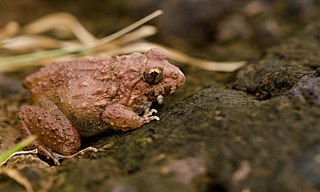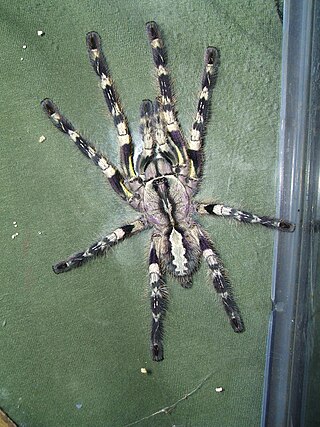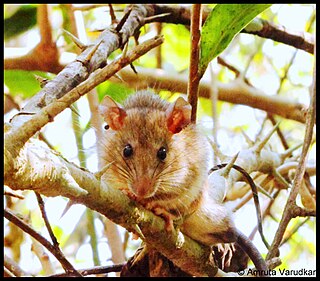
The Western Ghats, also known as the Sahyadri, is a mountain range that stretches 1,600 km (990 mi) along the western coast of the Indian peninsula. Covering an area of 160,000 km2 (62,000 sq mi), it traverses the states of Gujarat, Maharashtra, Goa, Karnataka, Kerala, and Tamil Nadu. The range forms an almost continuous chain of mountains along the western edge of the Deccan Plateau, from the Tapti River to Swamithoppe in Kanyakumari district at the southern tip of the Indian peninsula. The Western Ghats meet with the Eastern Ghats at Nilgiris before continuing south.

The Malabar Coast moist forests are a tropical moist broadleaf forest ecoregion of southwestern India.

Karwar is a seaside city, taluka, and administrative headquarters of Uttara Kannada district lying at the mouth of the Kali river on the Kanara coast of Karnataka state, India.

Minervarya rufescens is a species of frog that is endemic to the Western Ghats, India. It occurs in Maharashtra, Karnataka, Goa, and Kerala states. It is a locally common species associated with riparian and forest edge habitats in open and lightly degraded tropical moist semi-evergreen forests.

Poecilotheria is a genus of tarantulas native to India and Sri Lanka. It was first described by Eugène Louis Simon in 1885. They are arboreal tarantulas, commonly known as ornamental tarantulas, known for their vivid color patterns, fast movement, and potent venom compared to other tarantulas. As of 2019 all species are protected under CITES.

Poecilotheria metallica, also known as the peacock tarantula, is an Old World species of tarantula. It is the only blue species of the genus Poecilotheria. Like others in its genus it exhibits an intricate fractal-like pattern on the abdomen. The species' natural habitat is deciduous forest in Andhra Pradesh, in central southern India. It has been classified as Critically endangered by the IUCN.

Rhacophorus lateralis is a rhacophorid tree frog endemic to the Western Ghats in South India. It has several common names: small tree frog, Boulenger's tree frog, small gliding frog, and winged gliding frog. After its original description in 1883 by George Albert Boulenger, the frog was rediscovered in Coorg in 2000 and has since been found in many parts of the Western Ghats around southern Karnataka and northern Kerala. Along with R. malabaricus, it is one of the few anuran amphibians in India that constructs its nest above the ground using leaves.

Poecilotheria regalis is a species of arboreal tarantula and is found in parts of India. The common name for this spider is Indian ornamental tree spider, or simply Indian ornamental. It is one of the most popular arboreal tarantulas for amateur collectors. Their leg span sometimes exceeds 7 inches (18 cm).

Tarantulas comprise a group of large and often hairy spiders of the family Theraphosidae. As of December 2023, 1,100 species have been identified, with 166 genera. The term "tarantula" is usually used to describe members of the family Theraphosidae, although many other members of the same infraorder (Mygalomorphae) are commonly referred to as "tarantulas" or "false tarantulas". Some of the more common species have become popular in the exotic pet trade. Many New World species kept as pets have setae known as urticating hairs that can cause irritation to the skin, and in extreme cases, cause damage to the eyes.

Idiops is a genus of armored trapdoor spiders that was first described by Josef Anton Maximilian Perty in 1833. It is the type genus of the spurred trapdoor spiders, Idiopidae. Idiops is also the most species-rich genus of the family, and is found at widely separated locations in the Neotropics, Afrotropics, Indomalaya and the Middle East. Females live in tubular burrows lined with a thick layer of white silk. These typically have a D-shaped lid that fits into the entrance like a cork, and some burrows have two entrances. The lid may consist of mud, moss or lichen, which is bound below by a thick layer of silk. As in all genera of this family, the anterior lateral eyes (ALE) are situated near the clypeal margin, far in front of the remaining six eyes, which are arranged in a tight group. The males which are smaller in size, wander about or occasionally live in burrows. Like other mygalomorphs, they are relatively large and long-lived. Forest clearance and agricultural practices that loosen the soil and enhance erosion, besides soil removal for brick making have been pointed out as serious threats to some Indian species. Species ranges are poorly known – in India for instance, most species are known only from their type localities.

The Sahyadris forest rat is a species of rat belonging to the family Muridae. It is native to the northern Western Ghats in India where it is split between three regions, Satara in Maharashtra, the Nilgiri mountains in Tamil Nadu and Kodagu district in Karnataka.
Poecilotheria miranda, also known as the Bengal ornamental is a species of tarantula. The species is endemic to India.

Poecilotheria striata, or the Mysore ornamental tarantula, is a large arboreal tarantula of the family Theraphosidae. It is endemic to India.

Poecilotheria formosa is a species of tarantula, commonly known as the salem ornamental, beautiful parachute spider, or finely formed parachute spider.

Poecilotheria vittata, sometimes called Pederson's ornamental, the ghost ornamental, or magam tiger spider, is an arboreal tarantula. It is endemic to Sri Lanka. In IUCN Red List, the species is cited as a synonym of Indian species Poecilotheria striata, but in other local text books and online publications, it is cited as a separate species. As of February 2016, the species was considered to be native to both India and Sri Lanka by the World Spider Catalog.

Poecilotheria rufilata, also known as the red slate ornamental, reddish parachute spider, Travancore slate-red, or rufus parachute spider, is an arboreal tarantula. It is endemic to South Western Ghats of India. It is classed as "endangered", threatened by habitat loss and smuggling for the pet trade.
Poecilotheria tigrinawesseli, also known as Wessel's tiger ornamental or Anantagiri's parachute spider, is an arboreal tarantula. It is endemic to Eastern Ghats of India and known from six locations around Andhra Pradesh.

Chilobrachys fimbriatus, commonly known as the Indian Violet Earth Tiger Tarantula usually shortened to Indian Violet Tarantula, is a species of spider of the genus Chilobrachys. It is endemic to India, and was first described by Reginald Innes Pocock in 1899.

Cynarospermum asperrimum is a species of flowering plant belonging to the family Acanthaceae. It is a subshrub endemic to the Western Ghats of western India. It is the sole species in genus Cynarospermum.
Indirana duboisi, the Karnataka leaping frog or Dubois's leaping frog, is a frog. It is endemic to India in the Western Ghat mountains.



















